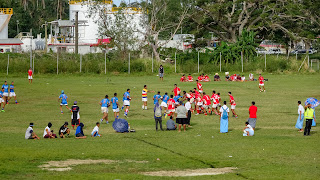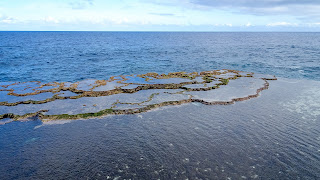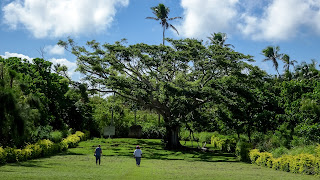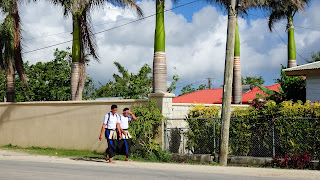Tonga - Shipwreck Diving Spectacle
Tonga’s vast kingdom spans many islands, but with limited infrastructure and rare flights, I opted to stay on beautiful Tongatapu instead of venturing out. The risk of missing my onward flight to Tuvalu wasn’t worth the stress.
Tonga holds a storied place in Polynesian history—it’s recognized as its birthplace, with 3000 years of heritage. It remains the only kingdom in the South Pacific, standing strong amidst the tides of time.
 |
| Map of Tongatapu |
May 18 – The Long Journey to Tonga
 |
| From Nauru to Tonga |
Tonga’s airport sits far from the city center—30 minutes one way—but thankfully, my hotel had arranged a pickup, sparing me the hassle of finding transport after such a long trip.
Though I usually prefer booking accommodation well in advance, I didn’t do so for Tonga—mostly to avoid negotiations with taxi drivers. But with the unpredictability of Oceania’s flights, delays, and cancellations, I honestly hadn’t expected to even make it here today. In fact, I half-expected to be stranded in Kiribati right now instead.
By morning, the hotel taxi dropped me in central Nuku’alofa, where I wasted no time organizing my plans—securing scuba diving and a rental car for the next four days. The tourist information office was efficient and welcoming, quickly helping me arrange everything. Tourism here is well-developed, especially with frequent cruise ship arrivals.
Tiny Nuku'alofa City Center
The capital is small—its “downtown” is little more than a single 200-meter-long road.
Like many places in Oceania, most shops and restaurants are run by Chinese owners, selling familiar goods.

Scuba Diving
Tonga has three dive shops, and weeks before arriving, I had already sent emails to all of them, eager to book a dive. Only one replied.
Today, I visited them in person—all three share the same communal area, door to door. The verdict? The other two shops only operate when cruise ships are in town. The third? They require at least two divers.
And I was the only one. Which meant: no diving in Tonga for me.
May 19 – With the rental car around Tongatapu
Picked up the rental car yesterday and wasted no time—at sunrise, I hit the road, determined to make the most of my time. I had to return the car by late afternoon, just before the weekend arrived.Driving in Tonga!
Still in Nuku’alofa, I stumbled upon a rugby match—how could I possibly pass that up? Tonga ranks 12th in the world, making it one of the strongest rugby nations.
Local school teams faced off in their traditional uniforms, showcasing skill and intensity that explained why Tonga is among the best.
Easy driving through Tongatapu
Driving around the island was effortless—few roads, easy navigation with a simple map or GPS.
But weather in Tonga is unpredictable. Within minutes, skies transform—clouds shift, sunlight vanishes, changing the scenery in an instant. I tried planning my route based on light conditions, but in the end, it didn’t matter—the sun moves too quickly to control.
One curious palm tree caught my attention: the Three-Headed Coconut Tree—a rarity, standing apart from the countless other giant trees scattered across the island.
But there are many other normal trees.
No pressure to rush
Not too many points of views on the island of Tongatapu. The ones which are the most important can easily be covered in one day. For example:a) Cliffs Overlook (South Coast). A stunning rocky shoreline where waves crash relentlessly. Not ideal for swimming, but incredible for watching. When it rains, reaching this spot by car is a challenge.
b) Fishing Pigs (North Coast). Something I’d never seen before—pigs, big and small, wading through low tide, hunting for fish and shells.
Their shell-cracking is so loud, I heard it from 100 meters away.
Yes, fishing pigs among whole families and fishermen fishing – such an amusing view.
Yes, fishing pigs among whole families and fishermen fishing – such an amusing view.
c) Mapu 'A Vaea Blowholes (South Coast). Stretching for kilometers, these natural blowholes put on a show as waves force water high into the air. Swimming? Not advised.
d) Ha’amonga ‘A Maui Trilithon. A mysterious stone monument—Tonga’s own Stonehenge. I hadn’t researched its origin, but like most ancient shrines, it likely carried spiritual significance.
e) Tsunami Rock (East Coast). A massive boulder, hurled here by a powerful tsunami—impossible not to marvel at the strength of the waves that moved it.
Interesting funerals
As mentioned, there aren’t too many hotspots but the villages itself contain lots of interesting things.Beyond landmarks, the villages themselves offered insights into Tongan culture.
One of the most fascinating traditions? Burials.
Instead of digging deep graves, bodies are buried above ground, covered in sand dunes. A practical approach—it allows relatives to visit and see something tangible, rather than an empty plot of earth.
Even the dogs seem to appreciate it, often sleeping atop the sandhills, lingering near their late masters.
During funerals, the coffin is paraded through the village, accompanied by relatives and friends, dressed in traditional attire, playing music as part of the ceremony.
In one village there was a funeral happening and they literally still drag the dead people in their coffin through the whole village, accompanied by a long queue of relatives and friends who play instruments and wear traditional clothes.
The flying fox tree
There is also one tree, the only one on the whole island with flying foxes and all foxes live there in that specific tree. Went to make photos and then a local appeared and threw small stones at it to make it fly away.The Friendliness of Tongans
Despite my car rental mishap, the hospitality in Tonga was overwhelmingly positive.Strangers smiled, shouted hellos across streets, and radiated genuine warmth. Tonga is a deeply religious nation, with locals attending church services every Sunday—and often singing church songs in their backyards during the week.
Many situations like that I noticed when just walking through the streets of Noku’alofa.
I had minimal expectations before arriving, but I was glad to find Tonga untouched by Western influence—not a hybrid of Australian culture, but authentically Polynesian.
I expected it to be a typical island culture influenced by New Zealand and Australia, which means a highly adopted behavior among Tongan people from these countries.
Great to see it's not yet like that.
Obesity also in Tonga
Tonga ranks second in the world for obesity, just behind Samoa.
Curiously, I didn’t see many visibly overweight people on the streets—maybe they were home, indulging in their ramen noodles?
One thing’s for sure—portions here are huge. My meal of lamb chops with rice was deliciously overwhelming—not a bad way to end the day.
Rental car has to be cleaner on the return than on pickup??
By afternoon, I returned the car on time, but the owner wasn’t pleased. The sides were splattered with mud—a natural outcome of driving around Tonga.
I didn’t feel like arguing—after all, it’s a rental car, meant for use. Dirt comes with the deal. But they insisted it had to be cleaned before handing it back.
So, I asked for a towel and some water to wipe off the few muddy spots myself and made a spectacle of scrubbing.
May 20 – Sunday in Tonga: Church for Them, Diving for Me
In Tonga, Sundays are treated much like Shabbat in Israel—everything shuts down. Not a single restaurant, shop, or even gas station is open.Everyone is singing on Sunday!
Most people spend the day relaxing, dressed in traditional attire, heading to church. One thing is impossible to ignore—singing fills the air from morning till night.
As I walked toward the harbor, I paused outside a church, peeking in from the entrance hall. Inside, the energy was overwhelming—people were dancing, singing at the top of their lungs, fully immersed in the moment.
The setup was fascinating: a projector displayed lyrics up front, allowing the congregation to sing along, much like karaoke—but with divine fervor.
Tonga is full of churches, each unique in style. The largest one stands in the center of Nuku’alofa, an architectural masterpiece among the diverse places of worship dotting the island.
But what truly sets Tongan church music apart is its rhythm and intensity—so much more alive than the solemn hymns I’ve heard in Western Christian churches. The songs are catchy, the atmosphere uplifting.
If church services back home were this lively, I bet attendance would skyrocket!
Walking in Nuku’alofa on a Sunday is interesting. There are the churches with the high energized singing people and also all over the town pigs are squeezing as well. I guess they will be the protein source for the many families who attended the church and come back home hungry for the Sunday feast.
Diving in Pangaimotu - Finally, Some Water!
Going to the small island Pangaimoto on Sunday is a good thing to do. Went there in the morning and returned in the afternoon.The island is 15 minutes from Nuku’alofa. The reason why I mainly wanted going there was that of the huge shipwreck, which is 50 meters from the shore and is there since the beginning of the last century.
Unfortunately, they didn’t have any fins to rent which made the diving and staying on the surface a little difficult, for taking photos.
A cyclone tore through the island a month ago, leaving behind a trail of destruction. Renovation efforts were underway, and signs of the storm’s impact were everywhere. Despite that, the restaurant staff remained welcoming, serving delicious fish and chips.
No Humpback Whales—Just a Rusty Wreck
Tonga is famous for its humpback whale sightings, attracting tourists eager to dive and snorkel with them.
Unfortunately, I wasn’t here during whale season—so no sightings for me. Still, as I swam around the rusting shipwreck, I couldn’t help but imagine—doesn’t it kind of resemble a humpback whale itself?
Time flies on Pangaimotu—morning slips into afternoon, and with it, the sunlight shifts. Above and below the water, the wreck takes on different tones, giving it a whole new look. Locals gather on the wreck, soaking in the Sunday sun.
But after a few hours, it was time to head back to the mainland. A boat comes every hour, ferrying visitors back to Nuku’alofa.
Around the wreck, there weren’t many corals, but at least some had survived.
Without full scuba gear, I couldn’t stay below long enough to observe the marine life properly, but I still managed to take in glimpses of small fish darting between the rusted metal.
Tomorrow - The Flight to Tuvalu
Tomorrow afternoon, I fly to Fiji, and the next day, to Tuvalu.
I just hope there are no delays—one hiccup could mean missing my flight to Fiji, which would throw off the entire itinerary—including my connecting flight to Tuvalu and the later departure to Samoa.
Fingers crossed.






























































Search for Tonga Volcano erruption 2022 brought me to your site and thought it shows the damage. But good to see how it was befor.
ReplyDelete